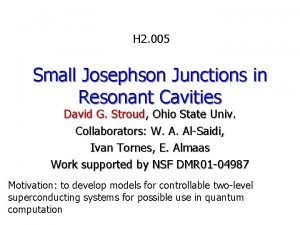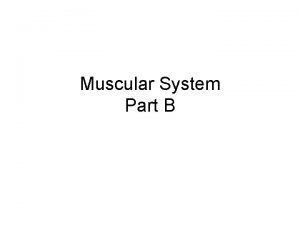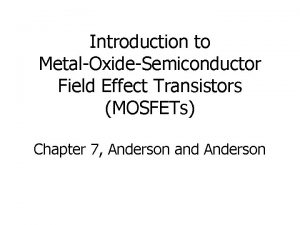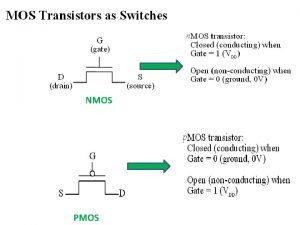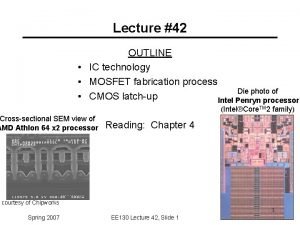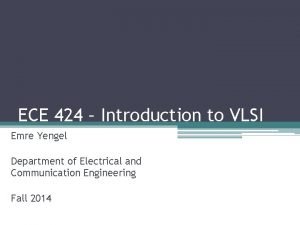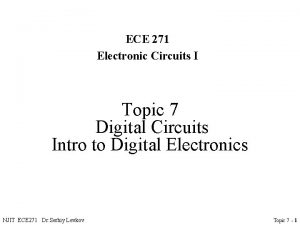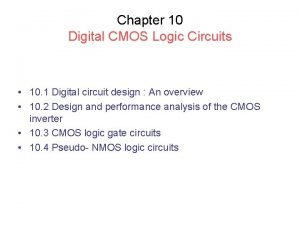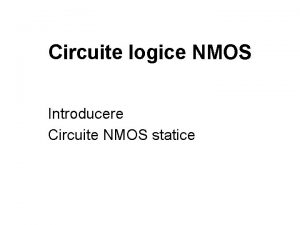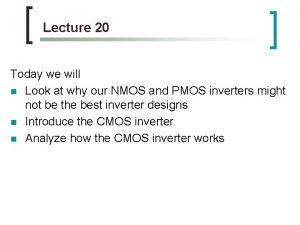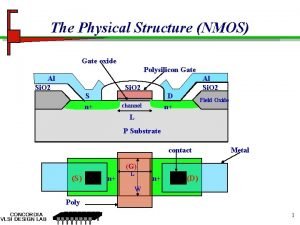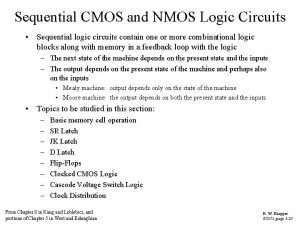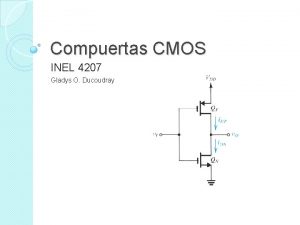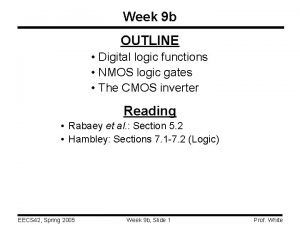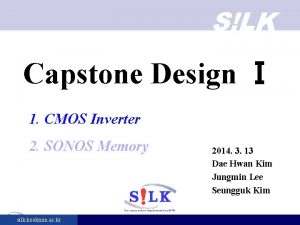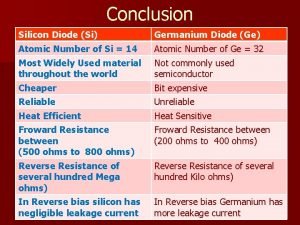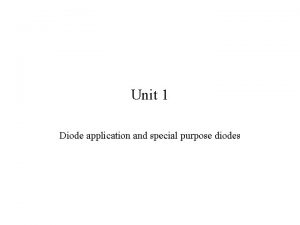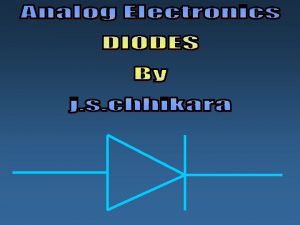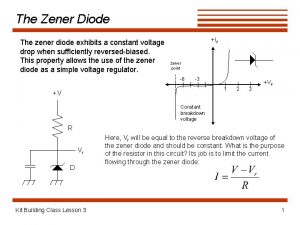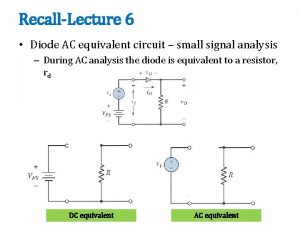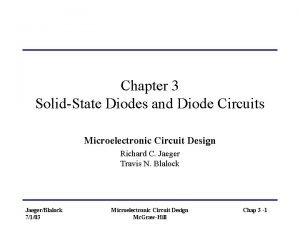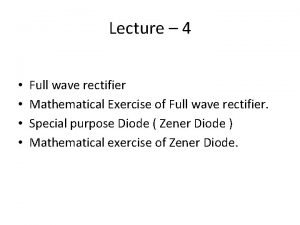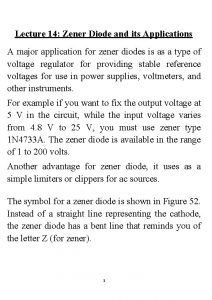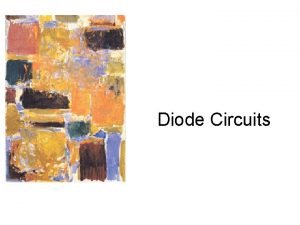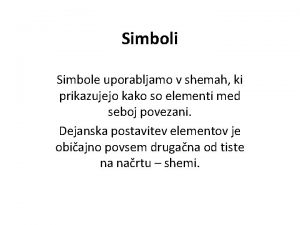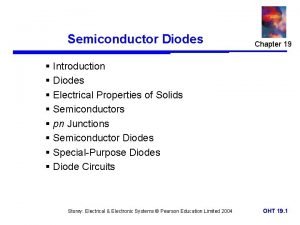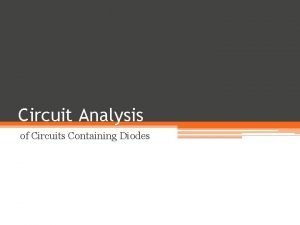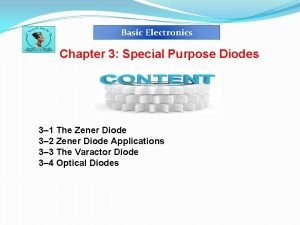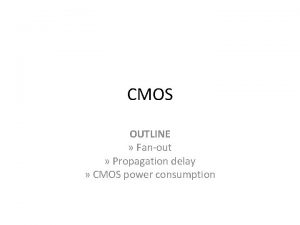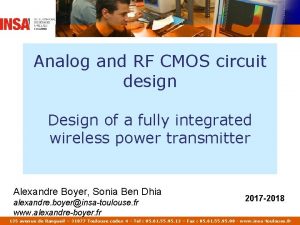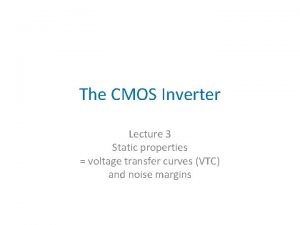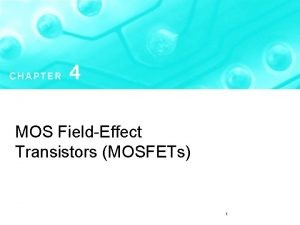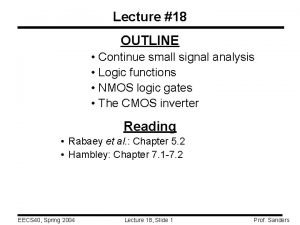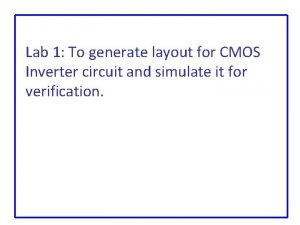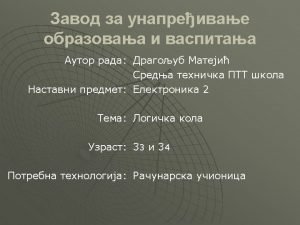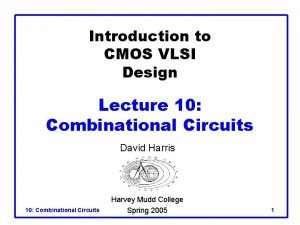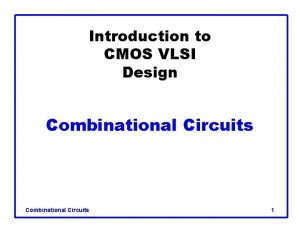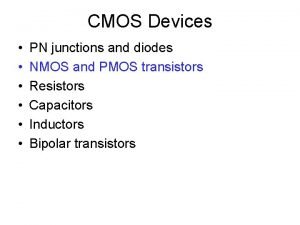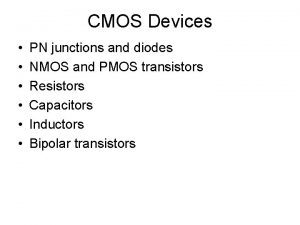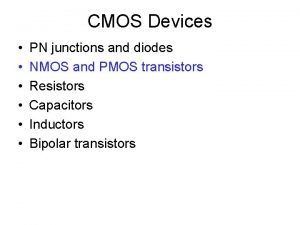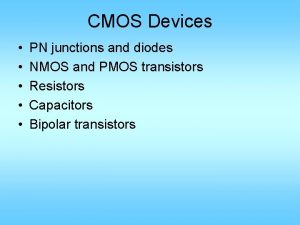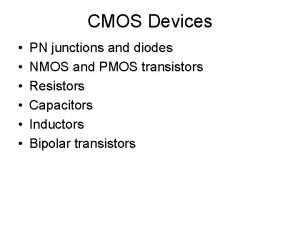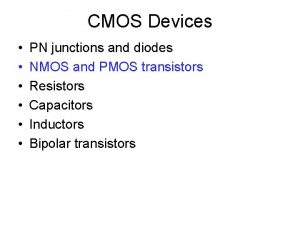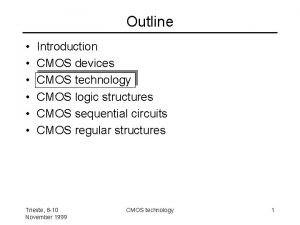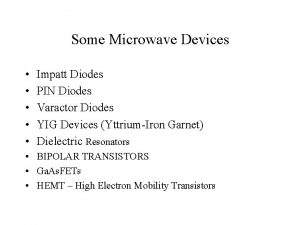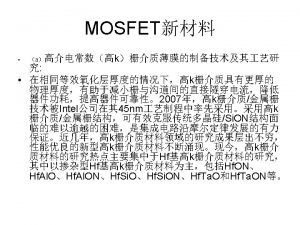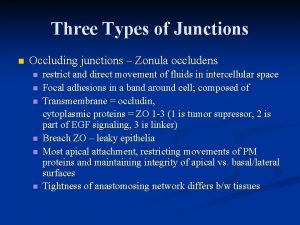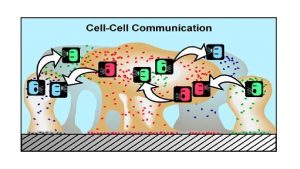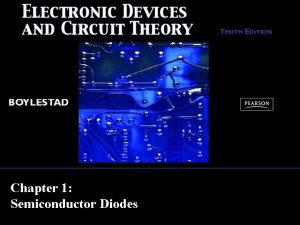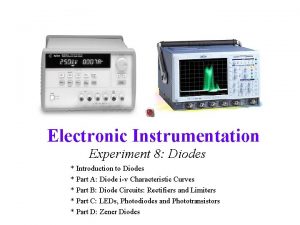CMOS Devices PN junctions and diodes NMOS and




















































- Slides: 52

CMOS Devices • • • PN junctions and diodes NMOS and PMOS transistors Resistors Capacitors Inductors Bipolar transistors

PN Junctions Charges on two sides equal but opposite sign.

PN Junctions Depletion region widths: Built-in potential:

PN Junctions The depletion charge The junction capacitance

• Can be used as voltage controlled capacitor • Here m = 1/2 for the step change in impurity concentration. • For gradual concentration change, m = 1/3. Real case is somewhere in between. mj and Cj 0 per unit area can be found from the pdk.

Impurity concentration profile for diffused pn junction

Current density at boundary due to holes: Total: Diode current:

The MOS Transistors

Capacitors • Two conductor plates separated by an insulator form a capacitor • Intentional capacitors vs parasitic capacitors • Linear vs nonlinear capacitors Linear capacitors: Non-linear:

Capacitor specifications 1. Dissipation (quality factor) of a capacitor 2. Parasitic capacitors to ground from each node of the capacitor. 3. The density of the capacitor in Farads/area. 4. The absolute and relative accuracies of the capacitor. 5. The Cmax/Cmin ratio which is the largest value of capacitance to the smallest when the capacitor is used as a variable capacitor (varactor). 6. The variation of a variable capacitance with the control voltage (is it linear). 7. Linearity, q = Cv.

PMOS on Substrate Gate Capacitors High density, good matching, but nonlinear

NMOS in p-well Gate Capacitor • Gate as one terminal of the capacitor • Some combination of the source, drain, and bulk as the other terminal

Gate Capacitor vs. VGS with D=S=B

3 -seg Approximation

Gate Capacitor in Inversion Mode VSS

Inversion Mode NMOS Capacitor E. Pedersen, “RF CMOS Varactors for 2 GHz Applications, ” Analog Integrated Circuits and Signal Processing, vol. 26, pp. 27 -36, Jan. 2001.

PN Junction Capacitors in a Well

PN-Junction Capacitors E. Pedersen, “RF CMOS Varactors for 2 GHz Applications, ” Analog Integrated Circuits and Signal Processing, vol. 26, pp. 27 -36, Jan. 2001.

Poly-poly cap on FOX High density, good matching, good linearity, but require two-poly processes

Poly-poly cap on STI • Very linear • Small bottom plate parasitics

Metal-insulator-metal cap

Fringe Capacitors

R. Aparicio and A. Hajimiri, “Capacity Limits and Matching Properties of Integrated Capacitors, ” IEEE J. of Solid-State Circuits, vol. 37, no. 3, March 2002, pp. 384 -393.


Comparison

Non-ideal Behavior • • • Dielectric gradients Edge effects Process biases Parasitics Voltage dependence Temperature dependence

Parasitic Capacitors


Proper layout of capacitors For achieving CA = 2 CB, which one is better?

Various Capacitor Errors


Temperature and Voltage Dependence • MOSFET Gate Capacitors: – – Absolute accuracy ≈ ± 10% Relative accuracy ≈ ± 0. 2% Temperature coefficient ≈ +25 ppm/C° Voltage coefficient ≈ -50 ppm/V • Polysilicon-Oxide-Polysilicon Capacitors: – – Absolute accuracy ≈ ± 10% Relative accuracy ≈ ± 0. 2% Temperature coefficient ≈ +25 ppm/C° Voltage coefficient ≈ -20 ppm/V • Metal-Dielectric-Metal Capacitors: – Absolute accuracy ≈ ± 10% – Relative accuracy ≈ ± 0. 6% – Temperature coefficient ≈ +40 ppm/C° – Voltage coefficient ≈ -20 ppm/V, 5 ppm/V 2 • Accuracies depend upon the size of the capacitors.

Improving Cap Matching • Divide each cap into even # of unit caps • Each unit cap is square, has identical construction, has identical vicinity, has identical routing • The unit caps for match critical caps are laid out with inter-digitation, common centroid, or other advanced techniques. • Same comments apply to resistors and transistors

Resistors in CMOS • • • Diffusion resistor polysilicon resistor well resistor metal layer resistor contact resistor

Resistor specs

Diffusion resistor in n-well

Source/Drain Resistor

Polysilicon resistor on FOX

Polysilicon Resistor

n-well resistor on p-substrate

N-well Resistor

Metal Resistor

Thin Film Resistors

Passive RC Performance

Parasitic Bipolar in CMOS Vertical PNP Horizontal NPN

Latch-up problem

Preventing Latch-up

Guard Rings • Collect carriers flowing in the silicon • Bypass unwanted currents to VDD or VSS • Isolate sensitive circuits from noise and/or interferences

Butted Contacts and Guard Rings • To reduce sensitivity • To prevent latch up

Intentional Bipolar • It is desirable to have the lateral collector current much larger than the vertical collector current. • Lateral BJT generally has good matching. • The lateral BJT can be used as a photodetector with reasonably good efficiency. • Triple well technology allows the current of the vertical collector to avoid the substrate.

Donut PMOS as bipolar • A Field-Aided Lateral BJT – Use minimum channel length – enhance beta to 50 to 100 • Can be done in ON 0. 5 or TSMC 0. 18 – No STI

ESD protection • A very serious problem • Not enough theoretical study • Many trade secrets • Learn from experienced designers
 Similarities between desmosomes and hemidesmosomes
Similarities between desmosomes and hemidesmosomes Synapses
Synapses Dr vani gupta
Dr vani gupta Microorganismos comensales
Microorganismos comensales Adding a junction in hec-ras
Adding a junction in hec-ras Smooth muscle contraction vs skeletal muscle contraction
Smooth muscle contraction vs skeletal muscle contraction Josephson junctions
Josephson junctions Asynchronous recruitment of motor units
Asynchronous recruitment of motor units Nmos and pmos symbols
Nmos and pmos symbols Vds
Vds Pmos nand
Pmos nand Nmos inverter with enhancement load
Nmos inverter with enhancement load Pmos fabrication process steps
Pmos fabrication process steps Nmos inverter with depletion load
Nmos inverter with depletion load Nmos inverter with resistive load
Nmos inverter with resistive load Nmos logic circuits
Nmos logic circuits Inversor nmos
Inversor nmos Nmos inverter
Nmos inverter N+ polysilicon gate
N+ polysilicon gate Cmos sr latch
Cmos sr latch Nmos iv curve
Nmos iv curve Inversor nmos
Inversor nmos Nmos
Nmos Inverter cross section
Inverter cross section Conclusion about diode
Conclusion about diode Diodes
Diodes Special purpose diode
Special purpose diode What are diodes made of
What are diodes made of Zener diodes exhibit
Zener diodes exhibit Small signal diode model
Small signal diode model What are special purpose diodes
What are special purpose diodes Voltage across diode
Voltage across diode Full wave rectifier 4 diodes
Full wave rectifier 4 diodes Zener diode and its application
Zener diode and its application Diode symbol
Diode symbol Mesh analysis with diodes
Mesh analysis with diodes Simbol potensiometer
Simbol potensiometer Introduction to diodes
Introduction to diodes Circuit analysis with diodes
Circuit analysis with diodes Special purpose diodes
Special purpose diodes Comparison of logic families table
Comparison of logic families table Literary devices definition
Literary devices definition What is input and output devices
What is input and output devices Fan in cmos
Fan in cmos Device modeling for analog and rf cmos circuit design
Device modeling for analog and rf cmos circuit design Lod effect sa sb
Lod effect sa sb Cmos inverter characteristics
Cmos inverter characteristics Cmos cross section
Cmos cross section Cmos inverter small signal model
Cmos inverter small signal model Cmos inverter microwind
Cmos inverter microwind Cmos logicka kola
Cmos logicka kola Skewed gates
Skewed gates Compound gate cmos
Compound gate cmos






